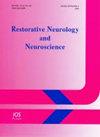Revisiting two clinical techniques for diagnosing myasthenia gravis in Covid times: Pointing to semiology
IF 1.6
4区 医学
Q4 NEUROSCIENCES
引用次数: 0
Abstract
As it has been evident in these times of the Covid-19 pandemic, the majority of health resources have been focused to the acute treatment, vaccination or research to this condition. By these reasons, some confirmatory complementary tests in many pathologies cannot be made or are postponed, including Myasthenia Gravis. Two clinical neurological signs useful for diagnosis of Myasthenia Gravis are revised: the “Curtain Sign” (also called paradoxical ptosis), that is evoked opening the more closed eye, which results in a dropping of the contralateral eyelid; and the Mary-Walker maneuver, which results from repetitive pronation-supination exercise under anaerobic conditions in one or both arms resulting in increasing of bilateral ptosis. The importance of a presumptive early diagnosis of Myasthenia Gravis is the early onset of specific treatment even when it’s impossible to carry out complementary studies like single-fiber electromyography, thoracic images, or specific immune studies. .重症肌无力的两种临床诊断方法:以符号学为切入点
正如在2019冠状病毒病大流行期间所显示的那样,大部分卫生资源都集中在对这种疾病的急性治疗、疫苗接种或研究上。由于这些原因,包括重症肌无力在内的许多病理的一些确证性补充检查不能进行或被推迟。对诊断重症肌无力的两种临床神经学症状进行了修订:“帘子征”(也称为悖论性上睑下垂),这是由于打开较闭的眼睛引起的,导致对侧眼睑下垂;以及Mary-Walker手法,在无氧条件下,在单臂或双臂进行反复的旋前-旋后运动,导致双侧上睑下垂增加。重症肌无力的早期诊断的重要性在于早期的特异性治疗,即使不可能进行补充研究,如单纤维肌电图、胸部图像或特异性免疫研究。
本文章由计算机程序翻译,如有差异,请以英文原文为准。
求助全文
约1分钟内获得全文
求助全文
来源期刊
CiteScore
5.40
自引率
3.60%
发文量
22
审稿时长
>12 weeks
期刊介绍:
This interdisciplinary journal publishes papers relating to the plasticity and response of the nervous system to accidental or experimental injuries and their interventions, transplantation, neurodegenerative disorders and experimental strategies to improve regeneration or functional recovery and rehabilitation. Experimental and clinical research papers adopting fresh conceptual approaches are encouraged. The overriding criteria for publication are novelty, significant experimental or clinical relevance and interest to a multidisciplinary audience. Experiments on un-anesthetized animals should conform with the standards for the use of laboratory animals as established by the Institute of Laboratory Animal Resources, US National Academy of Sciences. Experiments in which paralytic agents are used must be justified. Patient identity should be concealed. All manuscripts are sent out for blind peer review to editorial board members or outside reviewers. Restorative Neurology and Neuroscience is a member of Neuroscience Peer Review Consortium.

 求助内容:
求助内容: 应助结果提醒方式:
应助结果提醒方式:


